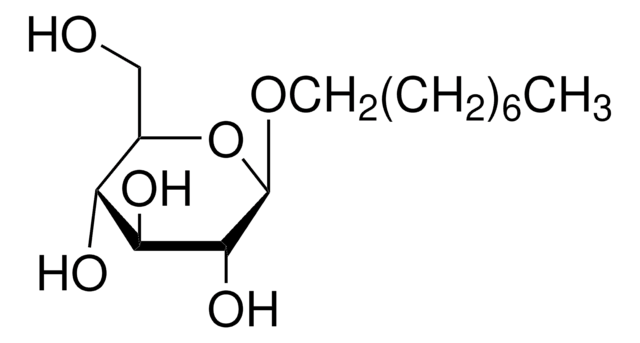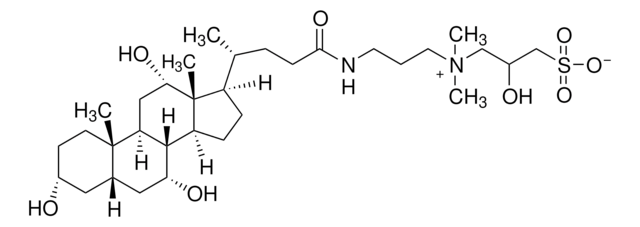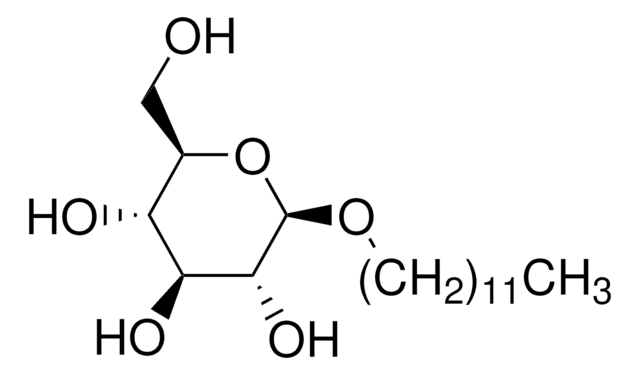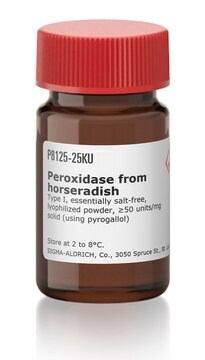Wszystkie zdjęcia(1)
Kluczowe dokumenty
O3757
Octyl β-D-glucopyranoside solution
≥95% (HPLC), 50 % (w/v) in H2O
Synonim(y):
n-Octyl glucoside, OGP
Zaloguj sięWyświetlanie cen organizacyjnych i kontraktowych
About This Item
Wzór empiryczny (zapis Hilla):
C14H28O6
Numer CAS:
Masa cząsteczkowa:
292.37
Numer MDL:
Kod UNSPSC:
12161902
Identyfikator substancji w PubChem:
NACRES:
NB.22
Polecane produkty
opis
non-ionic
Próba
≥95% (HPLC)
masa cząsteczkowa
average mol wt 24500-25000
stężenie
50 % (w/v) in H2O
liczba agregacji
84
CMC
20-25
temp. przejścia
cloud point ≥100
Zastosowanie
detection
temp. przechowywania
−20°C
ciąg SMILES
CCCCCCCCO[C@@H]1O[C@H](CO)[C@@H](O)[C@H](O)[C@H]1O
InChI
1S/C14H28O6/c1-2-3-4-5-6-7-8-19-14-13(18)12(17)11(16)10(9-15)20-14/h10-18H,2-9H2,1H3/t10-,11-,12+,13-,14-/m1/s1
Klucz InChI
HEGSGKPQLMEBJL-RKQHYHRCSA-N
Zastosowanie
Do homogenizacji siatkówki myszy użyto 2,5% glukopiranozydu n-oktylu β-D
β-D-glukopiranozyd n-oktylu (OGP) jest niejonowym detergentem, który został użyty do ogniskowania izoelektrycznego (IEF) i dwuwymiarowej elektroforezy (2D). Wykazano, że OGP jest lepszy od 988 X-100 do IEF białek roślinnych. n-Octyl β-D-glucopyranoside został również użyty do zatężania białek z żeli 2D do trawienia i analizy spektroskopii masowej.
Informacje prawne
Triton is a trademark of The Dow Chemical Company or an affiliated company of Dow
Ta strona może zawierać tekst przetłumaczony maszynowo.
Kod klasy składowania
10 - Combustible liquids
Klasa zagrożenia wodnego (WGK)
WGK 3
Temperatura zapłonu (°F)
Not applicable
Temperatura zapłonu (°C)
Not applicable
Wybierz jedną z najnowszych wersji:
Masz już ten produkt?
Dokumenty związane z niedawno zakupionymi produktami zostały zamieszczone w Bibliotece dokumentów.
Klienci oglądali również te produkty
M F Lopez
Journal of chromatography. B, Biomedical sciences and applications, 722(1-2), 191-202 (1999-03-06)
Two-dimensional electrophoresis has rapidly become the method of choice for resolving complex mixtures of proteins. Since the technique was pioneered in 1975, 2-D gel methods have undergone a series of enhancements to optimize resolution and reproducibility. Recent improvements in the
P J Holloway et al.
Analytical biochemistry, 172(1), 8-15 (1988-07-01)
A technique for the analysis of plant proteins from seed, leaf, root, and coleoptile tissues by high resolution two-dimensional electrophoresis is described. This technique is based primarily on the procedure of P. O'Farrell (1975, J. Biol. Chem. 250, 4007-4021); however
Compartment-specific phosphorylation of phosducin in rods underlies adaptation to various levels of illumination.
Song H, et al.
The Journal of Biological Chemistry (2007)
P Dainese Hatt et al.
European journal of biochemistry, 246(2), 336-343 (1997-06-01)
We have developed a gel electrophoresis system that can concentrate proteins from spots cut out of up to 50 two-dimensional electrophoresis gels. During protein concentration, SDS is substituted with a non-ionic detergent (octyl beta-glucopyranoside) which allows digestion and MS analysis
Christine Ménager et al.
Langmuir : the ACS journal of surfaces and colloids, 26(19), 15453-15463 (2010-09-10)
The present study deals with the morphological modifications of giant dioleoyl phosphatidylcholine vesicles (DOPC GUVs) induced by the nonionic surfactant n-octyl β,D-glucopyranoside at sublytic levels, i.e., in the first steps of the vesicle-to-micelle transition process, when surfactant inserts into the
Nasz zespół naukowców ma doświadczenie we wszystkich obszarach badań, w tym w naukach przyrodniczych, materiałoznawstwie, syntezie chemicznej, chromatografii, analityce i wielu innych dziedzinach.
Skontaktuj się z zespołem ds. pomocy technicznej











